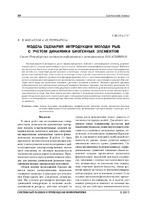| dc.contributor.author | Михайлов, В. В. | ru |
| dc.contributor.author | Переварюха, А. Ю. | ru |
| dc.coverage.spatial | Минск | ru |
| dc.date.accessioned | 2017-07-31T09:41:12Z | |
| dc.date.available | 2017-07-31T09:41:12Z | |
| dc.date.issued | 2017 | |
| dc.identifier.citation | Михайлов, В. В., Переварюха А. Ю. Модель сценария интродукции молоди рыб с учетом динамики биогенных элементов = Simulation scenario of introduction of fish whitebait with the account of biogenic elements dynamics / В. В. Михайлов, А. Ю. Переварюха // Системный анализ и прикладная информатика. - 2017. – №2. - С. 20-28. | ru |
| dc.identifier.uri | https://rep.bntu.by/handle/data/31860 | |
| dc.description.abstract | Рассматривается расширение ранее сформулированного подхода к моделированию аспектов репродуктивного цикла с учетом происходящих перемен в среде обитания и метаморфозов в развитии рыб. Избыточное накопление биогенных элементов при длительном использовании водоемов для искусственного выращивания молоди или ускоренный распад органики в некоторых случаях могут оказывать влияние на успешность процесса воспроизводства, косвенно влияя на долговременные тренды популяционной динамики. В отдельных случаях усиление притока органического фосфора приводит далее к состоянию эвтрофикации и может сказаться на недостаточной аэрации мест размножения, привести к гипоксии у вылупившихся личинок. При массовой гибели икры еще ухудшится ситуация с расходом кислорода в водоеме. Нехватка органики приводит к недостаточному для оптимального роста рыб развитию биомассы кормовых планктонных организмов. Система уравнений выживаемости конкурирующих особей поколения дополнена функциональным расширением, использующим итерационную модель динамики биогенных элементов, построенную на основе анализа процессов в экосистеме озера Чао. Блок модели расчёта притока и деструкции органики синхронизирован с непрерывно-дискретной вычислительной структурой, учитывающей взаимосвязанные изменения факторов смертности и темпов развития молоди рыб при переходах между обобщенными эколого-физиологическими этапами развития. | ru |
| dc.language.iso | ru | ru |
| dc.publisher | БНТУ | ru |
| dc.subject | Модели популяций | ru |
| dc.subject | Эвтрофикация | ru |
| dc.subject | Трофодинамика водоемов | ru |
| dc.subject | Темпы накопления биогенов | ru |
| dc.subject | Аспекты эффективности воспроизводства | ru |
| dc.subject | Предикативно переопределяемые структуры | ru |
| dc.subject | Этапы онтогенеза | ru |
| dc.subject | Models of populations | en |
| dc.subject | Eutrophication | en |
| dc.subject | Trophodynamics of aquatic environment | en |
| dc.subject | Nutrients accumulation | en |
| dc.subject | Reproductive efficiency | en |
| dc.subject | Predicatively redefined structures | en |
| dc.subject | Stages of ontogeny | en |
| dc.title | Модель сценария интродукции молоди рыб с учетом динамики биогенных элементов | ru |
| dc.title.alternative | Simulation scenario of introduction of fish whitebait with the account of biogenic elements dynamics | en |
| dc.type | Article | ru |
| dc.relation.journal | Системный анализ и прикладная информатика | ru |
| local.description.annotation | The article discusses the expansion of the previously formulated approach to modeling aspects of the reproductive cycle, taking into account the changes in the habitat and metamorphosis in the development of fish. Excessive accumulation of nutrients with prolonged use of a reservoir for artificial growth of juveniles or accelerated decomposition of organic nitrogen and phosphorus may in some cases affect the success of the reproductive process. This creates an indirect effect on long-term trends in population dynamics. In some cases, the increase in the influx of organic phosphorus further leads to a state of eutrophication and may affect the insufficient aeration of breeding sites, leading to hypoxia for hatched larvae. Even worsen the situation with the consumption of oxygen in the water at the mass destruction of eggs. Lack of organic matter leads to insufficient development of planktonic organisms for optimal growth of fishes. The system of survivability equations for calculation competing individuals of the generation is supplemented by a functional extension using an iterative model of biogenic elements dynamics, based on the analysis of processes in the ecosystem of Lake Chao. The block of the model for calculating the inflow and destruction of organic matter is synchronized with a continuous-discrete computational structure that takes into account the interrelated changes in mortality factors and the rate of development of juvenile fish during transitions between generalized ecological and physiological stages of development. | en |

